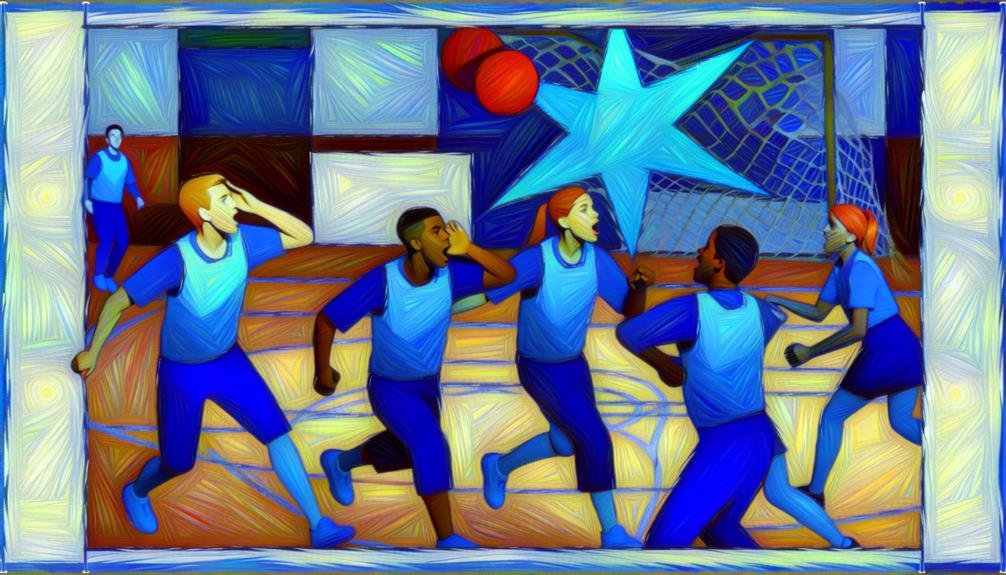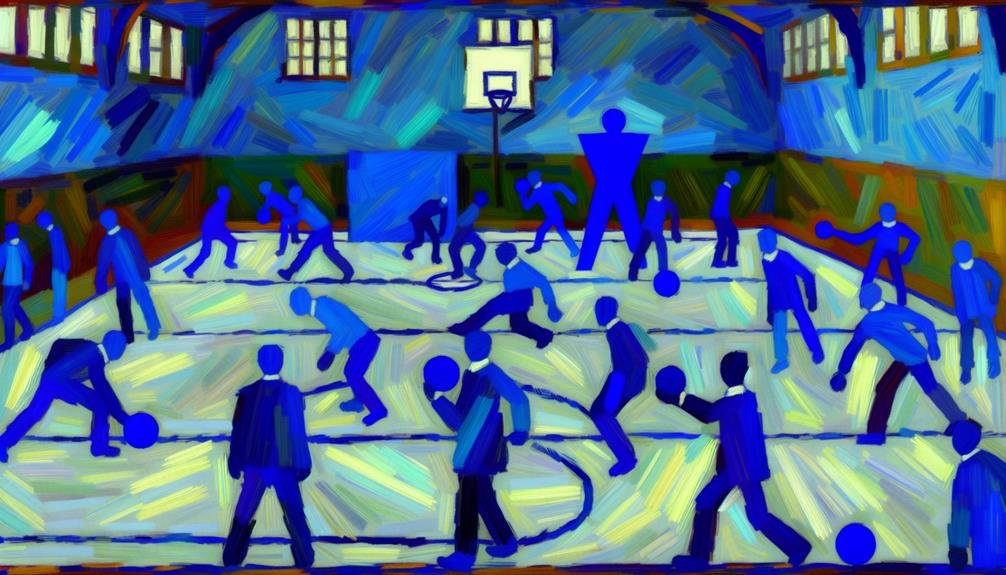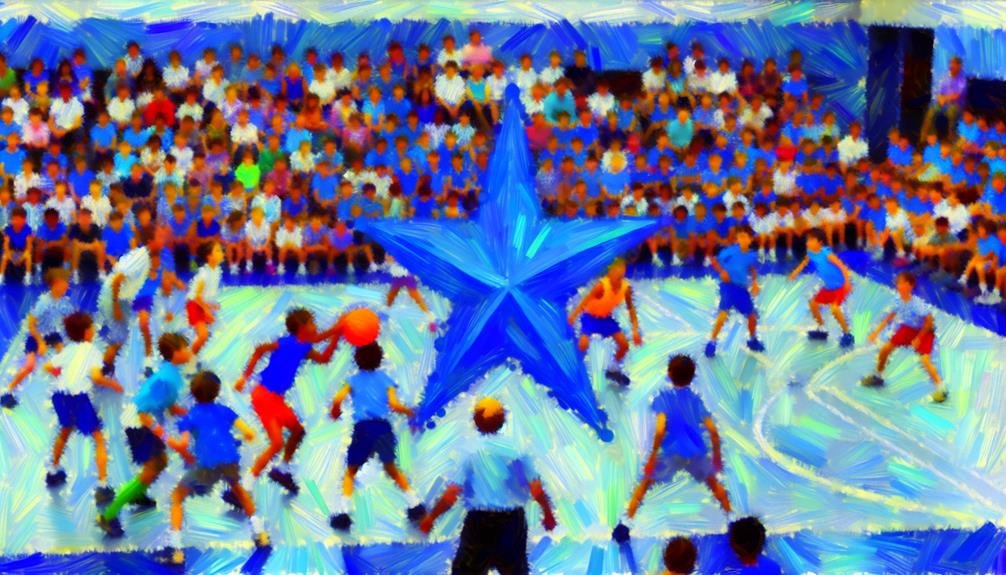Imagine this: dodgeball in schools is like a mixed bag of goodies – exciting yet not without its challenges. Dodgeball boosts your physical fitness, teamwork skills, and hand-eye coordination. It’s like hitting three birds with one dodgeball! But hold your horses, safety concerns like high-speed throws and potential injuries lurk in the shadows. And don’t forget about the risk of exclusion and not-so-friendly interactions. So, dodgeball at school is like a rollercoaster ride – exhilarating highs mixed with cautious moments. Just like any game, it has its pros and cons.
Takeaways
- Dodgeball enhances physical fitness, teamwork, and hand-eye coordination.
- It fosters social skills, teamwork, and cognitive abilities.
- Potential safety concerns include injuries like concussions and sprains.
- Dodgeball promotes camaraderie, unity, and sportsmanship.
- Proper supervision, rules, and equipment are crucial for a safe playing environment.
Benefits of Dodgeball in Schools
The incorporation of dodgeball in schools has been shown to provide students with physical, social, and cognitive benefits. Beyond the exhilarating thrills of dodging, ducking, dipping, diving, and dodging (the five D’s of dodgeball, as immortalized by Patches O’Houlihan in ‘Dodgeball: A True Underdog Story’), this classic game offers more than just a good time.
Physically, dodgeball gets the heart pumping, muscles moving, and energy flowing. It’s a fantastic way to sneak in some exercise while having a blast with friends.
Socially, dodgeball encourages teamwork, communication, and sportsmanship. Whether you’re the last one standing on your team or cheering from the sidelines, there’s a sense of camaraderie that comes with every throw and dodge.
Cognitively, dodgeball sharpens reflexes, strategic thinking, and decision-making skills. Quick reflexes are key to avoiding those rubber balls flying your way, while strategic thinking helps in planning your moves and outsmarting opponents.
Physical Fitness Enhancement
Enhancing physical fitness through the practice of dodgeball in schools offers students a dynamic and engaging way to improve their overall health and well-being. Dodgeball requires participants to move quickly, dodge incoming balls, and throw with precision, all of which contribute to cardiovascular endurance, agility, and hand-eye coordination.
The fast-paced nature of the game keeps players on their toes, literally, as they jump, duck, and dive to avoid being hit. This constant movement helps to increase stamina and burn calories, making dodgeball a fun alternative to traditional exercises.
Moreover, the game encourages full-body participation, engaging muscles in the arms, legs, and core. The repeated actions of throwing, catching, and running help to strengthen muscles and improve reflexes. Through regular play, students can develop their physical strength and endurance, leading to better overall fitness levels.
Teamwork Development Opportunities

Promoting collaboration and communication skills, dodgeball in schools provides valuable teamwork development opportunities for students. As teams strategize and work together to eliminate opponents, they learn the importance of coordination and support. Picture this: Sarah and Alex, two classmates who rarely interact in class, suddenly find themselves side by side on the dodgeball court. In the heat of the game, they start communicating, planning their moves, and covering each other’s backs. Through dodgeball, students like Sarah and Alex discover the power of unity and shared goals.
Teamwork in dodgeball goes beyond just throwing balls and dodging shots. It involves trust, quick decision-making, and adapting to unexpected situations. When students collaborate effectively in a game of dodgeball, they develop skills that are essential for success both in school and in future careers.
This cooperative spirit nurtured through dodgeball can create lasting bonds among classmates, fostering a sense of camaraderie and mutual respect. So, next time you step onto the dodgeball court, remember that you’re not just playing a game – you’re building valuable teamwork skills that will benefit you for life.
Improved Hand-Eye Coordination
Developing precise hand-eye coordination skills is a key benefit that students can gain from participating in dodgeball in schools. Dodgeball requires players to quickly react to incoming balls, accurately aim their throws, and coordinate their movements to dodge oncoming projectiles. These actions help students fine-tune their hand-eye coordination, an essential skill that can positively impact various aspects of their lives.
By playing dodgeball, students are essentially engaging in a fun and interactive hand-eye coordination training session. The game demands players to focus intently on the ball’s trajectory, adjust their position accordingly, and react swiftly to either catch or dodge it. Through repeated gameplay, students can enhance their ability to track objects visually and coordinate their hands to respond effectively.
Moreover, improved hand-eye coordination can extend beyond the dodgeball court. Students may find themselves excelling in activities such as sports, art, or even everyday tasks that require precise hand movements.
Potential Safety Concerns

Considering the physical nature of dodgeball and the potential for high-velocity throws and sudden movements, it is crucial to address the potential safety concerns associated with this sport in school settings. While dodgeball can be a fun and exciting game, there are risks involved that need to be carefully managed.
One major concern is the risk of players getting hit in the face or head by a fast-moving ball, which could lead to injuries such as concussions or facial trauma. Additionally, the quick and dynamic nature of the game increases the chances of players tripping, colliding with each other, or falling awkwardly, which could result in sprains, strains, or even fractures.
To guarantee the safety of students, proper supervision, clear rules, and appropriate equipment are essential when playing dodgeball in schools. Coaches and teachers should emphasize the importance of sportsmanship, fair play, and respect for opponents to create a positive and safe playing environment.
Risk of Exclusion and Bullying
One prominent concern associated with dodgeball in schools is the potential risk of exclusion and bullying among students during gameplay. While dodgeball can be a fun and energetic game, it’s essential to acknowledge the negative social dynamics that can arise in such a competitive environment. Here are some key points to take into account:
- Power Imbalance: Stronger or more aggressive students may target weaker or less athletic peers, leading to feelings of exclusion and inadequacy.
- Social Alienation: Constant elimination in dodgeball can make students feel left out and isolated from their peers, impacting their self-esteem.
- Negative Peer Interactions: The fast-paced nature of dodgeball can sometimes result in harsh or hurtful interactions between students.
- Lack of Teamwork: In some cases, dodgeball can promote individualistic behavior over teamwork, diminishing the sense of camaraderie among classmates.
- Potential for Bullying: Without proper supervision, dodgeball games can escalate into instances of bullying, causing long-lasting emotional harm to those involved.
Addressing these concerns through proactive measures and promoting positive social interactions is essential in creating a safe and inclusive environment for all students.
Negative Social Interactions

Negative social interactions in dodgeball settings can greatly impact students’ emotional well-being and peer relationships, highlighting the importance of fostering a supportive and respectful environment during gameplay.
When students experience taunting, exclusion, or aggressive behavior on the dodgeball court, it can lead to feelings of inadequacy, loneliness, and even resentment towards peers. These negative interactions can create a toxic atmosphere that erodes trust and camaraderie among students, hindering the development of healthy social skills and friendships.
Moreover, constant negative social interactions in dodgeball can perpetuate a cycle of bullying and intimidation, where certain students feel targeted or marginalized, further exacerbating feelings of alienation and low self-esteem.
As educators and facilitators, it is vital to address these issues promptly and proactively, promoting empathy, sportsmanship, and inclusivity within the dodgeball setting.
Frequently Asked Questions
Can Dodgeball Be Adapted for Students With Disabilities?
Adapting dodgeball for students with disabilities involves modifying the game to promote inclusivity and accessibility. By implementing alternative rules, equipment, or strategies, dodgeball can be tailored to accommodate diverse needs, fostering participation and engagement among all students.
What Is the Ideal Age Group for Dodgeball in Schools?
The ideal age group for dodgeball in schools typically ranges from upper elementary to middle school students. This age range allows for the development of fundamental motor skills and coordination necessary for safe and enjoyable participation in the game.
How Can Teachers Ensure Fair Team Selection in Dodgeball?
Teachers can promote fair team selection in dodgeball by implementing randomized selection methods, such as drawing names or assigning numbers. Additionally, they can consider skill levels to balance teams and promote inclusivity, fostering a positive and equitable playing environment.
Are There Alternative Versions of Dodgeball for Smaller Spaces?
Alternative versions of dodgeball, such as pinball dodgeball or doctor dodgeball, can be adapted for smaller spaces. These variations offer similar gameplay and excitement while accommodating limited areas, making them suitable for various indoor environments.
What Measures Can Be Taken to Prevent Aggressive Behavior During Dodgeball Games?
To prevent aggressive behavior during dodgeball games, schools can implement clear rules regarding appropriate conduct, provide proper supervision by trained staff, emphasize sportsmanship and teamwork, address any incidents promptly, and promote a positive and inclusive environment for all participants.
Conclusion
To sum up, when contemplating dodgeball, it is crucial to take into account the potential safety concerns, the risk of exclusion and bullying, as well as the negative social interactions that may arise during gameplay.
By addressing these issues and promoting positive sportsmanship, schools can create a more inclusive and enjoyable dodgeball experience for all students.

